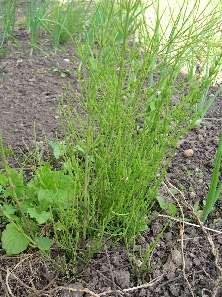 So the answer is not so simple because YES of course you can technically compost it - it will rot - BUT!!!!!!
So the answer is not so simple because YES of course you can technically compost it - it will rot - BUT!!!!!!Problems will arise if the heap does not get above 40 degrees C – the seeds will survive cold composting and you will spread the seeds when the compost is used. A hot compost heap (40-60*C) will kill the seeds but most of us using a traditional plastic compost bin at home with a small amount of waste are unlikely to be composting at this hot a temperature.
However as this is such an invasive and tough weed, you need to check that the seeds/bits are only added to the top of a already hot pile, that they stay near the top (do not fork in or turn the pile as seeds will fall down to cooler base). Finally, after hot composting, give your compost a ‘germination test’ – by this we mean leave the compost in an open maturation pile for a few months to check to ensure the Horsetail does not re-sprout. If it does, gently tease out all roots and rhizomes again and zap it through the hot compost again.
This may sound painstaking – but so will your efforts to remove it from soil in the first place. Are there any other options? Well whilst we generally take the view that burning anything you can compost is a waste of good fodder, perhaps this is one case where it is better to burn the weeds or use your local council garden waste collection service instead. The Council use industrial processing on local farms where they compost such huge piles that they get up to 60 degrees in their giant compost heaps / windrows.
■Horsetail or Mare’s Tail (Equisetum Arvense) is an invasive, deep-rooted perennial weed with fast-growing rhizomes (underground stems) that quickly send up dense stands of foliage that will spread quickly to form a dense carpet of foliage, crowding out less vigorous plants in beds and borders.
■Horsetail is easily recognised by its upright, fir tree-like shoots that appear in summer. In spring, fertile light brown stems, 20-50cm (10-20in) tall, appear with a cone-like spore producing structure at the end of the stems. In summer, sterile green shoots develop into fir tree-like plants, 60cm (2ft) tall.
■The creeping rhizomes of this pernicious plant may go down as deep as 2m (7ft) below the surface, making them hard to remove by digging out, especially if they invade a border. They often enter gardens by spreading underground from neighbouring properties or land.
You can also find more advice at: Garden Organic Website
No comments:
Post a Comment